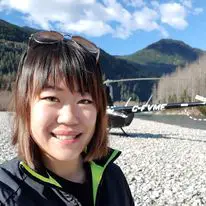Day in the life of
Co-Pilot – Kate Tian

My name is Kate Tian. I hold a commercial pilot’s license for both helicopters and airplanes in Canada with 2000 hours of flying experience.
I’m a Co-pilot on an air ambulance service in Alberta, and Aerobatic Pilot and owner at Thin Air Adventures in British Columbia.
My typical day
I work 15 days on duty from 7am to 7pm at the air ambulance service, where I must be ready for an emergency call. I start my day with a daily inspection on the helicopter and a morning briefing with my Captain. Typically on a call, my Captain and I fly two paramedics in the air ambulance to the scene. The scenes are usually in the remote part of Alberta.
Our air ambulance missions are normally alerted by a Link center, sometimes directly by paramedics. We would be given information like the location of the scene, the type of mission: emergency transfer, interfacility transfer, search and rescue, etc. If it is an accident, we as pilots will not know what happened at the scene, and how badly the injuries are, because our judgment of launching should not be based on the condition of the patient. Instead, it is based on weather and aircraft abilities. Pilots should never be so eager to save the patient’s life but risk the crews’ lives on board.
After getting the location details or coordinates of the scene, we will launch directly from the airport with two paramedics on board and fly directly to the scene with the most efficient speed and fuel consumption. At the scene, pilots will assist the paramedics in any way they need. After the patient is secured in the cabin, we fly to the closest hospital capable of meeting the patient’s needs. Our typical missions include inter-facility transfer and scene call (car crashes, injured bikers, etc).
During my off-duty days, I travel back to British Columbia and fly an aerobatic Chinese warplane for Thin Air Adventures.
I also work as a part-time flight instructor on my off-duty days. On a typical flight lesson, I will start with a pre-flight briefing. Then go on a training plane with my student. The flying lesson normally lasts an hour to an hour and a half. Finally, I finish the lesson with a post-flight briefing.
I spend most of the day waiting around for an emergency call. When the phone rings, all of our crew gets ready in minimal time and launch. Pilots can be under many different types of pressure on missions.
Pros
- I am passionate about flying. There are no bad days if I can be in the sky.
- Rewarding and meaningful job where I get to help people on what is likely the worst day of their life and save their lives!
- Amazing team of pilots and paramedics work together in a very professional manner.
- Ground crew support like firefighters at scenes to ensure landing areas are clear.
- Two pilots in the cockpit to ensure a high level of safety.
Cons
- Getting certified to be a commercial pilot is very exciting but expensive. The amount of paperwork involved in operating any aviation business is enormous.
- Flying conditions such as weather can be challenging. Our landing area can often be off airport, such as a field, a highway, a road, sometimes someone’s backyard.
- Pilots can experience self-induced pressure.
- Not a lot of flying hours per year.
Advice for students who are interested to become a pilot
There are a lot of different types of pilot jobs. Examples of helicopter pilot jobs would be sightseeing, fire fighting, air ambulance, utility work, off-shore flying, flight instructing, etc.
Typically someone needs to complete a hundred hours of flight training with 80 hours of ground knowledge courses in Canada to get a commercial helicopter license. Transport Canada also requires the candidate to pass a written exam and a flight test in order to issue a license.
Finding a flying job right away after school can be difficult. There are normally ground crew positions available in helicopter companies, and a person can spend one to two years on the ground before flying full time.
Airline Pilots
pilot and navigate the flight of fixed-wing aircraft, usually on scheduled air carrier routes, for the transport of passengers and cargo. Requires Federal Air Transport certificate and rating for specific aircraft type used. Includes regional, national, and international airline pilots and flight instructors of airline pilots.



.jpg)